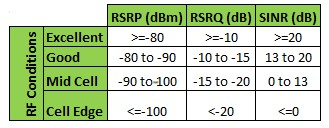LTE Signal Strength Values
Below is a chart that shows what values are considered good and bad for the LTE signal strength values:

Below are explanations of these values (and also RSSI in relation to LTE):
SINR/SNR (Signal-to-Interference-plus-Noise Ratio):
- The signal-to-noise ratio of the given signal.
- This tells us how strong the signal is compared to background noise.
- Higher values mean a clearer, better connection.
RSRP (Reference Signal Received Power):
- The average power received from a single Reference signal, and Its typical range is around -44dbm (good) to -140dbm(bad).
- Measures the power of a specific signal from a cell tower.
- The closer this number is to zero (less negative), the better your connection.
RSRQ (Reference Signal Received Quality):
- Indicates quality of the received signal, and its range is typically -19.5dB(bad) to -3dB (good).
- Indicates how clean the signal is.
- A less negative number means better quality.
RSSI
- Represents the total received power, including the main signal and background noise.
- Represents the entire received power including the wanted power from the serving cell as well as all cochannel power and other sources of noise and it is related to the above parameters through the following formula:
RSRQ=N*(RSRP/RSSI)
Where N is the number of Resource Blocks of the E-UTRA carrier RSSI measurement bandwidth.
4G LTE RSSI vs RSRP
Last updated:
Feb 05, 2025